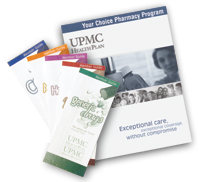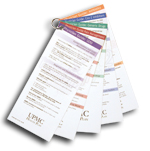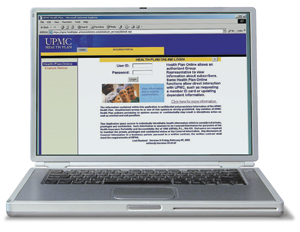| Keeping
in touch and being concerned about the health
of members is what UPMC Health Plan employees
do every day. For Terri Rosen, a registered nurse
in our Health Management department, this includes
coordinating a community outreach program based
at UPMC Braddock and UPMC McKeesport hospitals.
Her
efforts have increased the number of members who
receive mammograms and childhood health screenings.
Such preventive screenings can help diagnose cancer
and other medical problems in the early stages,
when treatment is more effective and less expensive.
In addition, she says, “Childhood visits
to a primary care physician can help prevent a
lifetime of poor health habits."
| Commercial
Members Rate UPMC Health Plan Superior to
Other Plans |
| |
|
Health
Plan 2002 |
Health
Plan 2001 |
National
Average 2002 |
 |
Doctors'
Communication Skills |
91.60% |
93.2% |
90.24% |
 |
Claims
Processing |
84.19% |
81.5% |
80.93% |
 |
Personal
Specialist |
82.49% |
81.3% |
76.48% |
 |
Getting
Needed Care |
82% |
82% |
76.07% |
 |
Getting
Care Quickly |
80.55% |
79.7% |
78.83% |
 |
Personal
Doctor or Nurse |
79.53% |
77.5% |
74.47% |
 |
All
Health Care (Last 12 Months) |
78.84% |
75.5% |
72.58% |
| Source:
2002 HEDIS/CAHPS Member Satisfaction Survey |
Commercial
Customers
Our offerings for commercial customers now include
enhanced-access health maintenance organization
plans, enhanced-access point-of-service plans,
and preferred provider organization plans. We
continue to refine existing products and develop
new ones that satisfy member needs and market
demand.

| Medicare
Expansion |
 |
| |
Medicare
Coverage Area in 2001 |
| |
Additional
Medicare Coverage Area in 2002 |
Medicare
Population
Nearly 20 percent of western Pennsylvania residents
are 65 or older, and Allegheny County has the
second highest percentage of Medicare-eligible
residents in the country—more than 440,000
in the greater Pittsburgh area alone. We’re
committed to serving this population.
While
other insurers have cut back or withdrawn from
the Medicare HMO business, we’re expanding
our offerings. With a program called UPMC for
Life, we’ve extended our Medicare HMO
to six more western Pennsylvania counties, bringing
the total of UPMC for Life HMO counties
to 13.

| Medicaid
Expansion |
 |
| |
Medicaid
Coverage Area in 2001 |
| |
Additional
Medicaid Coverage Area in 2002 |
Medicaid
Members
We provide benefits to a sizable Medicaid population
as well. In 2002, we renamed our Medicaid program.
“Best Health Care of Western Pennsylvania”
is now “UPMC for You.” The
new name better reflects the program’s connection
to the University of Pittsburgh Medical Center.
Our 72,000 UPMC for You members make
up 20 percent of our total enrollment.

Prescription
Choices
| 
|
 |
| UPMC
Health Plan pharmacy guides help doctors and
patients choose cost-effective alternatives
to brand-name drugs. |
Some
Retirees Look Abroad
for Prescription Drugs
—The New York Times, Sept. 24,
2002
Drug
Maker Threatens
to Stop Supplies to Canada
—The Associated Press, Jan. 11,
2003
States
Organizing a Nonprofit
Group to Cut Drug Costs
—The New York Times, Jan. 14, 2003
These headlines reflect the interdependent
financial concerns of insurance carriers and employers
who pay for drug benefits. Nationwide, the search
is on for ways to halt the spiraling cost of drugs,
which already exceeds $120 billion a year.*
To
help solve this problem, we introduced three strategies
in 2002:
- We
encouraged employers to use our three-tier Your
Choice program, with incentives for choosing
generic and preferred medications.
- We
developed guides to help remind physicians and
to educate patients about cost-effective alternatives
to heavily advertised brand-name drugs. The
guides address pain management, generic drug
effectiveness, and overuse of antibiotics.
- We
added CuraScript, a national mail-order pharmacy,
to our selection of benefits. CuraScript provides
maintenance drugs and injectable medications
as well as a program that helps patients stay
on their drug regimens.
| *
|
Source:
U.S. Centers for Medicare &
Medicaid Services, Jan. 2002 |

Investing
in Technology

Strategic
investments in online technology have improved
our efficiency, customer satisfaction, and cost
effectiveness:
- Member
OnLine, introduced as a test program, gives
employees easier access to benefit information.
In 2003, Member OnLine will be available to
all members.
- Provider
OnLine now includes a messaging function that
allows physicians and hospitals to communicate
securely with our claims department. We also
created a CD-ROM tutorial to walk physician
office staff through the online program.
- Broker
OnLine, introduced in 2002, enables us to process
group enrollments 75 percent faster than we
could in 2001.
- Employer
OnLine has attracted a dedicated user group
since it was introduced in 2001. More than 300
employer groups are using this service, and
we’ve processed 21,900 enrollments or
plan changes online.
More than 4,600 western Pennsylvania employers—including
some of Pittsburgh’s largest companies—now
offer UPMC Health Plan to their employees. These
employers appreciate the competition we bring
to the region, our network of quality hospitals
and facilities, and the range of health benefit
choices we offer.

Keeping
Expenses Down
| Operating
Expense Ratio |
2002
UPMC
Health Plan |
 |
8.97% |
2001
UPMC
Health Plan |
 |
10.6% |
2002
National
Average* |
 |
12% |
| Source:
Sherlock Company, 2002 |
Our
2002 operating expense ratio—the percentage
of premiums that goes toward payroll, equipment,
leases, and other overhead expenses—was
just 8.97 percent, less than half the rate of
our major competitor. And our trend in the first
quarter of 2003 is less than 8 percent.


|































